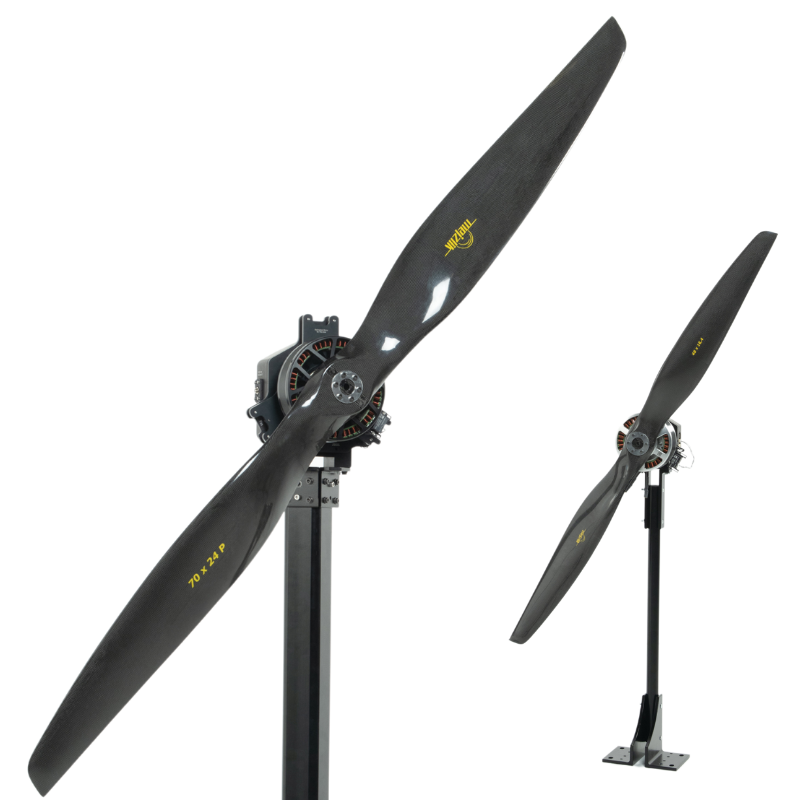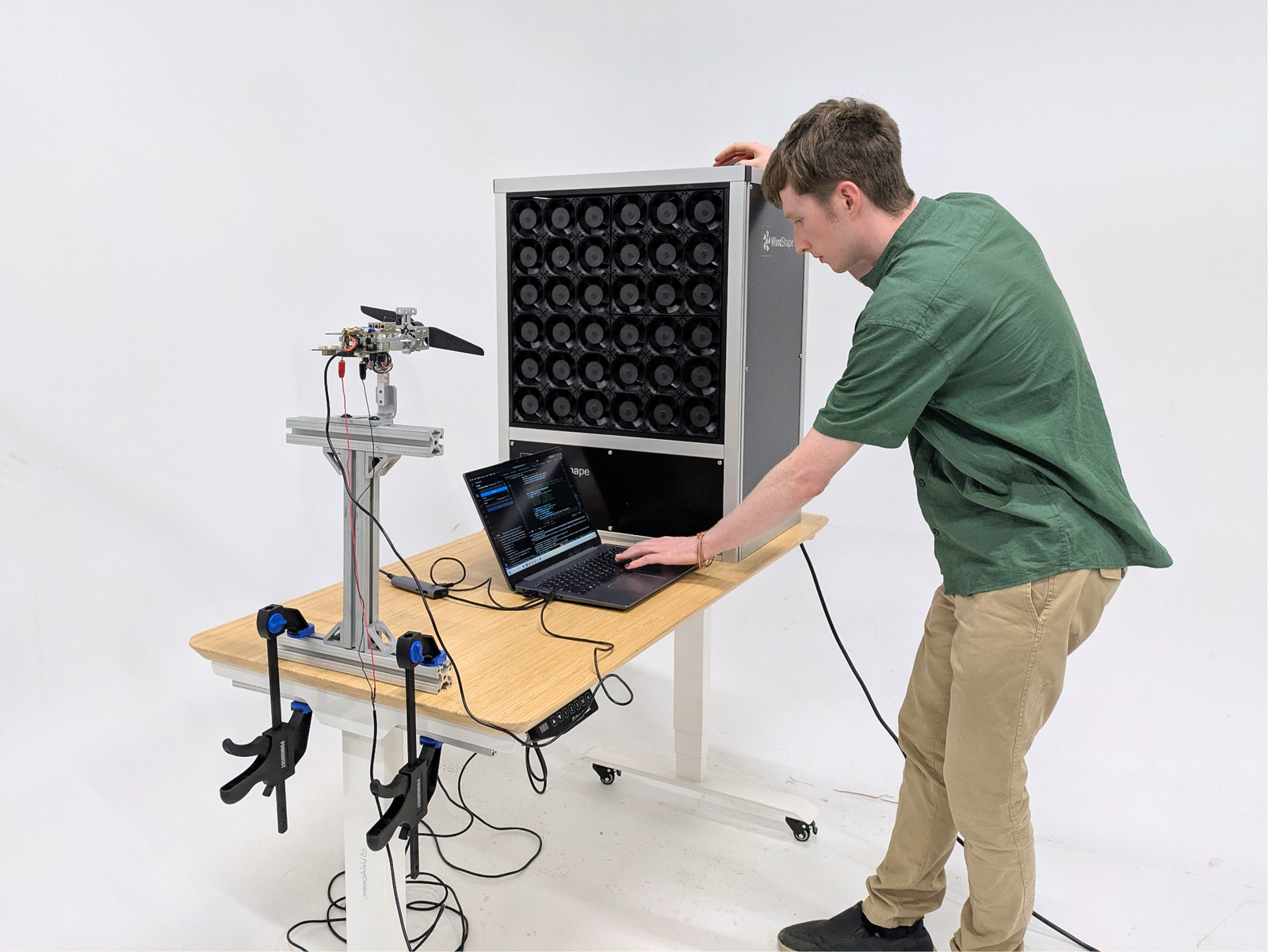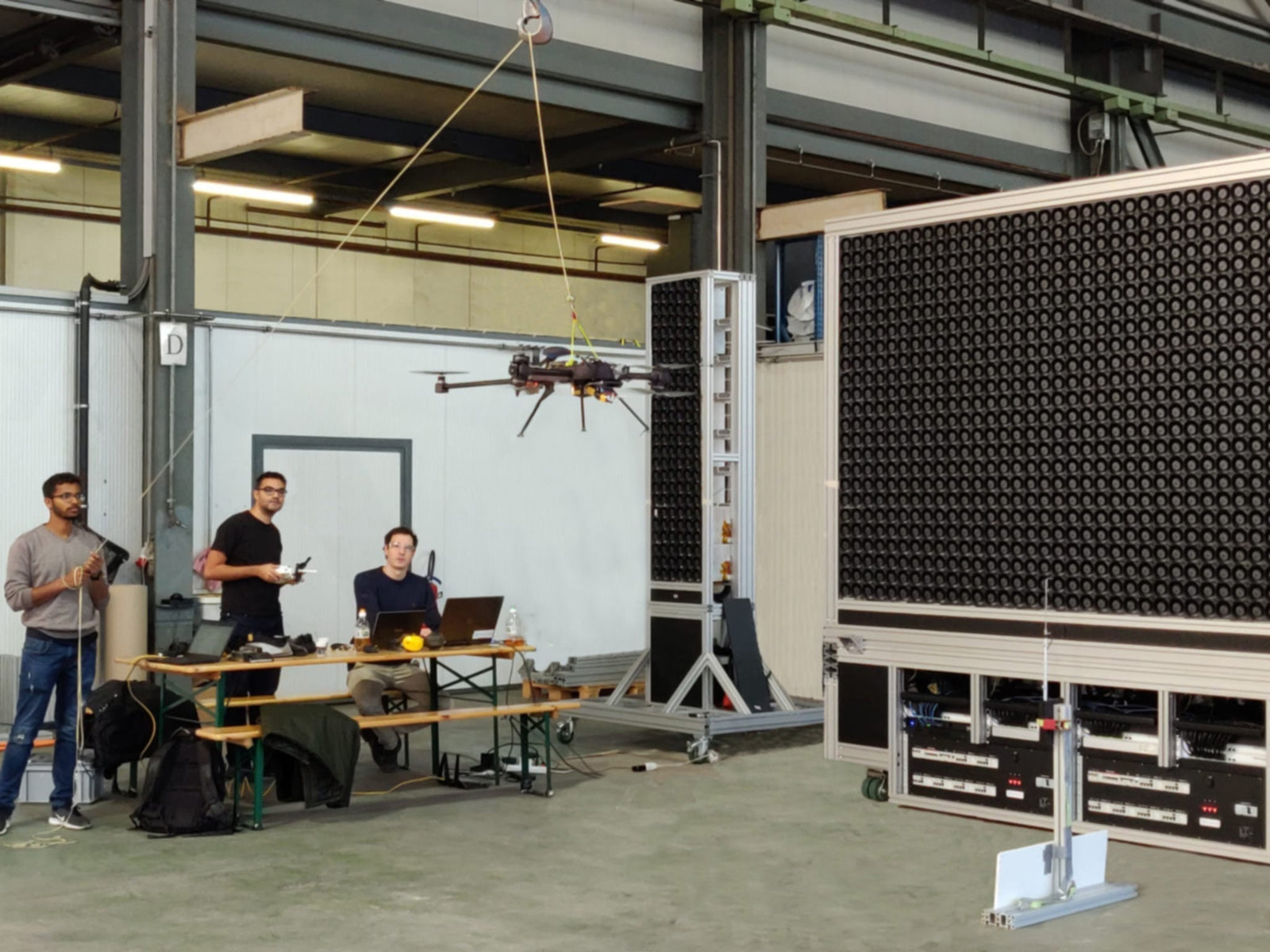By Lauren Nagel
Wind tunnel testing is an essential step in drone design and development, as propulsion systems often perform differently in static vs. real world conditions.
Propeller thrust and efficiency, for example, are crucial for mission completion, yet vary greatly with changing airspeed. Characterizing a drone’s performance at various airspeeds is key for any aircraft with operations beyond fair weather flying.
To test how propeller performance changes with airspeed, we put our prop testing station to use, testing drone propellers at airspeeds from 0 to 38 mph (0 - 17 m/s).
Table of Contents:
-
Wind tunnel testing procedure
-
Propeller thrust vs. RPM at different airspeeds
-
Propeller thrust : power ratios
- Propeller efficiency (2 ways)

Figure 1: Propeller wind tunnel test setup
1. Wind Tunnel Testing Procedure
Our test setup includes three key pieces of measurement equipment:
-
2x2 Windshaper - a modular wall of fans generating airspeeds of 16+ m/s, replacing the traditional wind tunnel. The speed and turbulence level of each individual fan is controlled using the WindControl software.
-
Series 1585 thrust stand - a propeller thrust stand measuring thrust, torque, rotation speed, current, and voltage in order to derive power and efficiency. Tests were automated using the Flight Stand software.
-
Airspeed pressure sensor - connected to a pitot tube and the Flight Stand software, airspeed data is synced with thrust stand measurements.

Figure 2: Series 1585 propeller thrust stand with airspeed sensor and pitot tube
We installed a 9” propeller at 210 cm from the Windshaper and ran an automated step test with four throttle steps: 1550, 1700, 1850, and 2000 µs.

Figure 3: Step test plotted in the Flight Stand software
Each test used a constant airspeed and turbulence level across the fans, and was repeated at 6 different speeds:
-
0 m/s (0 mph)
-
4.2 m/s (9.4 mph)
-
7.5 m/s (16.8 mph)
-
10.7 m/s (24 mph)
-
14 m/s (31.3 mph)
-
17 m/s (38 mph)

Figure 4: Windshaper fan power set to 100% (17 m/s) in the WindControl software
Thrust measurements were ‘tared’ by recording thrust at 0% throttle at each airspeed, and subtracting the measured thrust from the total thrust recorded at each throttle step. At the highest airspeed, the propeller was gently immobilized to prevent it from rotating during the baseline measurement. This effort aimed to isolate the thrust generated by the propeller.
Further Reading: CFD vs. Experimental Propeller Testing (Results)
Other considerations regarding the test setup:
-
It is essential to leave enough space behind the Windshaper to ensure efficient air intake
-
We made sure the entrance to the pitot tube was unobstructed to ensure measurement of smooth air
-
We aimed to minimize the distance between the pitot tube and the test propeller while limiting airflow disturbance. Next time we will visualize the aerodynamic flows with a WindProbe 3D.

Figure 5: 2x2 Windshaper wind wall with 36 individually controlled fans
2. Propeller Thrust vs. RPM at Different Airspeeds
The graph below shows the results for thrust generation vs. RPM in each wind condition. The four data points at each airspeed represent the readings at each throttle step.

Figure 6: Graph of propeller thrust vs. RPM at airspeeds from 0 to 17 m/s
Thrust generation increased as throttle increased and was highest in the no wind condition. As airspeed increased, a higher rotation speed was required to achieve the same thrust.
For a given thrust, propeller RPM increased as throttle input and airspeed increased. The wind from the Windshaper is responsible for the higher RPM, pushing on the propeller’s blades and causing it to rotate even faster.
Higher RPM is typically associated with higher thrust generation, but this is only true at constant airspeed. Propeller thrust depends on the physical properties of the propeller, i.e. radius, pitch, but also on the pressure of the air flowing through the propeller disk area.
The equation below for dynamic propeller thrust (Electric Aircraft Guy) demonstrates how propeller forward airspeed relates to thrust generation. Note that the coefficients are theoretical and will vary due to the propeller profile, Reynolds number, and environmental conditions.
Nevertheless, the equation is useful for understanding how changes to parameters will affect propeller thrust. For example, as forward airspeed increases, propeller thrust decreases.

This decrease in thrust occurs because thrust is a product of the velocity difference of the air entering and exiting the propeller. Propeller thrust can also be expressed as:

Further reading: How to Calculate Propeller Thrust (Static and Dynamic)
When a propeller is stationary, i.e. when an aircraft is at rest, the surrounding air is rapidly accelerated as it enters the propeller. When the aircraft accelerates and the propeller gains forward speed, the relative velocity of the air meeting the propeller blades (V0) increases, while Ve does not increase proportionally, resulting in lower thrust generation.
Additionally, as airspeed increases, there is a change in the relative airflow vector at the propeller. This vector represents the sum of the propeller’s rotational velocity vector and the airspeed vector. The angle between the relative airflow vector and the propeller chord line is the angle of attack. As the airspeed vector increases in magnitude, the angle of attack decreases, resulting in reduced thrust generation.

Figure 7: Change in propeller angle of attack with an increase in airspeed (Roddy Mc Namee)
Check out Roddy Mc Namee’s video on Propeller Blade Angle of Attack to learn more.
3. Propeller Thrust : Power Ratios
As airspeed increases, mechanical power decreases. In the graph below, we visualize thrust and power decline, as well as the thrust: to power ratio:

Figure 8: Propeller thrust, power, and thrust: power ratios at 9000 RPM
The graph compares thrust and power at 9000 RPM at each of the six airspeeds, deriving the values from their performance curves. The thrust to power ratio is simply the thrust divided by the power.
In the graph, it is clear that thrust declines more rapidly than power. Even though less thrust is generated as airspeed increases, a similar amount of power is drawn, resulting in a lower thrust: power ratio at higher airspeeds.
Between 0 and 17 m/s, thrust declines by 75%, whereas power only declines by 19%.
This translates into a decline in propeller efficiency at higher airspeeds, as we will see in the next section.
Recommended for you: 2 Methods for Balancing Drone Propellers
4. Propeller Efficiency (2 Ways)
Finally, we will look at propeller efficiency across airspeeds using two different approaches.
The first approach measures propeller efficiency in terms of grams of force of thrust generated per Watt of mechanical power, the product of torque and RPM:

Where thrust is measured in gf, torque is measured in Nm, and rotation speed is measured in RPM.
This equation provides a measure of propeller efficiency in gf/W, an intuitive way of evaluating propulsion system performance when dealing with VTOL aircraft like drones.
Since the reported value is not unitless, it is more accurately described as a performance metric.
A second way of evaluating propeller efficiency is by looking at the ratio of available power to mechanical power. This method is useful for taking into account aerodynamic efficiency and is especially relevant for forward flight, as simulated in our experiment:

Available power is the product of thrust and velocity. In a typical application, velocity would refer to the velocity of the aircraft itself, but since we are simulating this condition with a stationary propeller in a wind stream, we will use the velocity of the wind from the Windshaper, the relative effect being equal.
Therefore,

Where thrust is measured in N, wind velocity in m/s, torque in Nm, and rotation speed in rad/s.
Propeller efficiency is denoted “η” and is a unitless property, reported as a % below.
When we plot propeller efficiency vs. RPM at each airspeed, we see the following trend:

Figure 9: Propeller efficiency in gf/W and % vs. RPM across airspeeds
The two approaches provide similar results, with efficiency values converging at higher airspeeds. At lower airspeeds, efficiency declines and plateaus, whereas at higher airspeeds efficiency climbs before plateauing.
Efficiency can not be calculated at 0 m/s wind velocity using the second method as the 0 velocity results in 0% efficiency across the board.
The propeller efficiency values recorded at 17 m/s at the lowest throttle values were significantly negative in both cases (-182 gf/W and -3065%) and were therefore excluded from the graph to facilitate clearer comparison of the remaining data.
The propeller efficiency measured using the second method is useful for evaluating efficiency across airspeeds for a set RPM. This can be useful for determining an aircraft’s most efficient operating conditions.
Below we have fitted the propeller efficiency data with second-order polynomial curves to model performance across airspeeds. Each curve represents a different RPM setting.
Propeller efficiency increases up to a peak as airspeed increases, then declines again as the blade's angle of attack is reduced. The curves shift to the right with increasing RPM.

Figure 10: Propeller efficiency (%) vs. airspeed at different rotation speeds
This data can be useful when choosing an RPM or throttle setting based on flight conditions.
Conclusion
These experiments illustrate the fascinating relationship between airspeed and propeller thrust, power and efficiency. These types of experiments are essential for understanding how a propulsion system works in real flight conditions.
In this study, we used a 2x2 Windshaper wind tunnel to generate constant speed winds, but these machines are capable of much more. Click here to learn how Windshapers can help you improve your drone's performance.


 Back to Blog
Back to Blog


Leave a comment